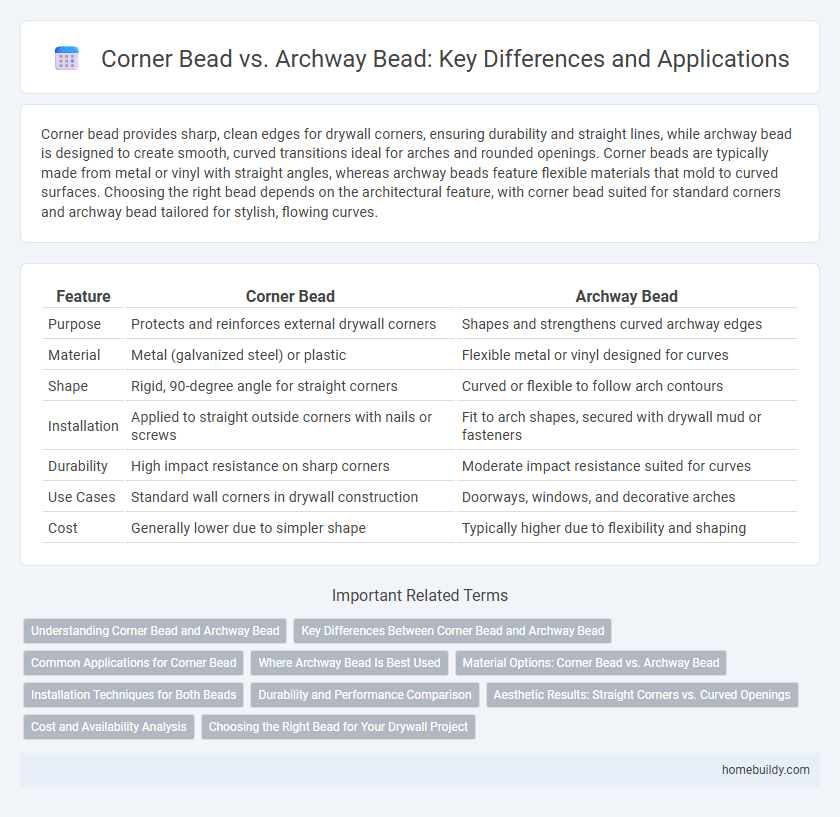Corner bead provides sharp, clean edges for drywall corners, ensuring durability and straight lines, while archway bead is designed to create smooth, curved transitions ideal for arches and rounded openings. Corner beads are typically made from metal or vinyl with straight angles, whereas archway beads feature flexible materials that mold to curved surfaces. Choosing the right bead depends on the architectural feature, with corner bead suited for standard corners and archway bead tailored for stylish, flowing curves.
Table of Comparison
| Feature | Corner Bead | Archway Bead |
|---|---|---|
| Purpose | Protects and reinforces external drywall corners | Shapes and strengthens curved archway edges |
| Material | Metal (galvanized steel) or plastic | Flexible metal or vinyl designed for curves |
| Shape | Rigid, 90-degree angle for straight corners | Curved or flexible to follow arch contours |
| Installation | Applied to straight outside corners with nails or screws | Fit to arch shapes, secured with drywall mud or fasteners |
| Durability | High impact resistance on sharp corners | Moderate impact resistance suited for curves |
| Use Cases | Standard wall corners in drywall construction | Doorways, windows, and decorative arches |
| Cost | Generally lower due to simpler shape | Typically higher due to flexibility and shaping |
Understanding Corner Bead and Archway Bead
Corner bead provides straight, durable edges for drywall corners, ensuring clean, sharp angles that resist chipping and wear. Archway bead is specifically designed for curved or rounded drywall edges, offering flexibility and smooth, flowing contours essential for archways or curved wall transitions. Selecting the appropriate bead depends on the architectural feature, with corner bead ideal for standard corners and archway bead for rounded finishes.
Key Differences Between Corner Bead and Archway Bead
Corner bead provides a straight, durable edge for drywall corners, enhancing protection against impacts and creating clean, crisp angles. Archway bead, designed for curved surfaces, enables smooth, flexible transitions on rounded drywall arches, conforming to curved shapes without cracking. The key differences lie in shape adaptation--corner bead supports sharp, 90-degree angles, while archway bead facilitates curved or arched drywall finishes.
Common Applications for Corner Bead
Corner bead is primarily used in drywall installations to create sharp, clean edges on outside corners, enhancing the durability and appearance of walls. It is commonly applied in residential and commercial construction for reinforcing 90-degree wall corners against impacts and wear. Unlike archway bead, which is designed for curved surfaces, corner bead provides straight, rigid support for angular corners in interior spaces.
Where Archway Bead Is Best Used
Archway bead is specifically designed for curved surfaces and is best used in creating smooth, rounded edges on archways and curved drywall installations. Unlike corner bead, which is ideal for sharp, 90-degree corners, archway bead accommodates gentle curves and arches, providing flexibility and a clean finish. Using archway bead ensures durability and aesthetics in areas that require rounded contours, such as decorative architectural elements and curved walls.
Material Options: Corner Bead vs. Archway Bead
Corner bead typically uses galvanized steel or vinyl materials for durability and ease of installation, providing sharp, straight edges for drywall corners. Archway bead often incorporates flexible options like metal or vinyl with a bendable core to accommodate curved surfaces while maintaining strength and shape. The choice of material impacts flexibility, corrosion resistance, and suitability for either sharp or rounded architectural features.
Installation Techniques for Both Beads
Corner bead installation requires precise alignment along drywall edges, securing with nails or adhesive to ensure sharp, durable corners. Archway bead demands flexible materials and careful bending to fit curved surfaces, often using plaster or setting compound for smooth adherence. Both techniques prioritize tight fitting and seamless integration to reinforce drywall corners and archways effectively.
Durability and Performance Comparison
Corner beads, typically made from galvanized steel or PVC, offer superior durability and resistance to impact, ensuring long-lasting protection for drywall corners. Archway beads, designed with flexible materials or perforated metal, provide enhanced performance in curved applications by maintaining shape without cracking. Durability favors corner beads for straight edges, while archway beads excel in performance on rounded or irregular surfaces.
Aesthetic Results: Straight Corners vs. Curved Openings
Corner bead provides clean, straight edges essential for sharp, angular corners, ensuring a polished and professional finish commonly seen in interior walls. Archway bead, by contrast, is designed to accommodate curved openings, allowing for smooth, rounded aesthetics that enhance the visual appeal of arches and curved structures. Selecting between corner bead and archway bead directly impacts the seamlessness and style of the finished surface, with each tailored to optimize either linear precision or gentle curvature.
Cost and Availability Analysis
Corner bead generally costs less than archway bead due to its simpler design and wider availability in hardware stores. Archway bead features complex curves and may require specialty suppliers, leading to higher prices and limited stock. Budget-conscious projects often favor corner bead for its cost-effectiveness and ease of procurement.
Choosing the Right Bead for Your Drywall Project
Corner bead provides durable protection and sharp, clean lines for standard drywall corners, ensuring long-lasting finishes. Archway bead is designed for curved surfaces, offering flexibility without cracks or deformation for arched openings. Selecting the right bead depends on your project's corner type, with corner bead ideal for straight edges and archway bead essential for smooth, curved drywall contours.
corner bead vs archway bead Infographic

 homebuildy.com
homebuildy.com